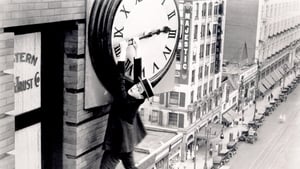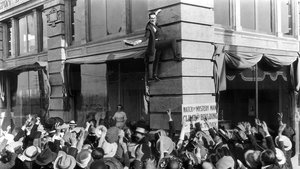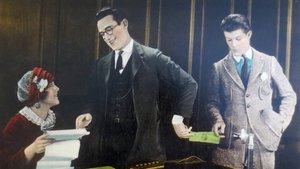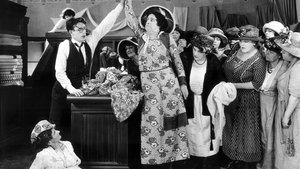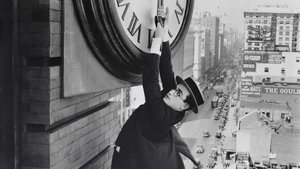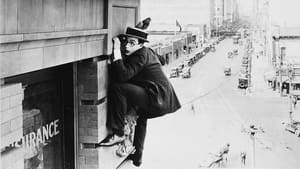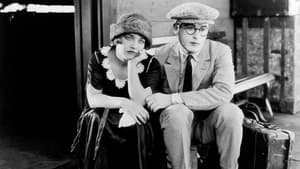Contact: info@alwanfilm.com
Video Sources 0 Views
- Watch trailer
- Safety Last! 1923

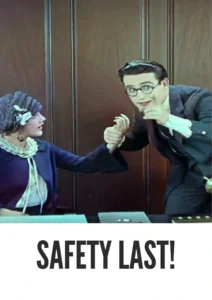
Synopsis
Table of Contents
ToggleReview: Safety Last 1923 Colorized – A Classic Silent Comedy Masterpiece in Brilliant Color

Introduction
“Safety Last!” (1923) stands as a timeless testament to the enduring appeal of silent cinema and the genius of its creators. In this article, we embark on a journey through the heart of this iconic film, exploring its significance as an early colored classic and its enduring legacy in the world of comedy.
Check The Full Colorized Movies List
Check Our Colorized Movies Trailer Channel
Understanding Safety Last 1923 Colorized Director, Cast, and Genre
Directed by the legendary Fred C. Newmeyer and Sam Taylor, “Safety Last!” (1923) showcases their mastery of silent comedy and visual storytelling. The film stars the incomparable Harold Lloyd, whose daredevil antics and heartwarming charm captivate audiences from start to finish. Blending elements of slapstick comedy, romance, and adventure, “Safety Last!” (1923) transports viewers to a world where laughter reigns supreme and anything is possible.
Exploring the World of Safety Last 1923 Colorized: Plot and Characters
At its core, “Safety Last!” (1923) follows the misadventures of a young man, portrayed by Harold Lloyd, who ventures to the big city in search of fortune and fame. Along the way, he encounters a series of hilarious obstacles and outrageous situations, culminating in a climactic stunt atop a towering skyscraper that has since become one of cinema’s most iconic images. Joined by a cast of colorful characters, including his sweetheart played by Mildred Davis, Lloyd’s journey is a rollercoaster ride of laughter and excitement that continues to delight audiences of all ages.
The Art of Film Colorization
Film colorization serves as a transformative tool that enhances the visual experience of classic movies, breathing new life into timeless stories and captivating audiences with vibrant hues. By digitally adding color to black and white films, colorization allows viewers to immerse themselves in the rich tapestry of cinematic worlds, exploring every nuance and detail with fresh eyes and renewed appreciation.
Early Colored Films: A Brief History
The history of colored films traces its roots back to the early days of cinema, with filmmakers experimenting with various techniques to add color to their creations. From hand-tinted frames to early Technicolor processes, the evolution of colored film has been marked by innovation and ingenuity, paving the way for the development of modern colorization techniques that continue to captivate audiences to this day.
Safety Last! 1923 and Its Early Colored Version
The decision to release “Safety Last!” (1923) in a colorized format was met with both anticipation and excitement. While some purists may have questioned the need to tamper with a silent classic, others welcomed the opportunity to experience the film in vibrant color. The early colored version of “Safety Last!” (1923) offers viewers a fresh perspective on Lloyd’s death-defying stunts and comedic genius, enhancing the film’s visual appeal and introducing it to a new generation of fans.
The Debate Over Film Colorization
The debate over film colorization is a contentious issue that continues to divide audiences and critics alike. While some argue that colorization breathes new life into classic movies and makes them more accessible to modern audiences, others contend that it compromises the artistic integrity of the original work and diminishes its historical significance. As the debate rages on, filmmakers and audiences are left to ponder the merits and drawbacks of colorization in the ever-evolving landscape of cinema.
Examining Safety Last! 1923 as an Early Colored Film
As with any colorized classic, the impact of colorization on “Safety Last!” (1923) is a matter of personal interpretation. Some may argue that it enhances the film’s visual appeal and immerses viewers in its world, while others may feel that it detracts from the stark beauty of the original black and white version. Regardless of one’s stance on the issue, there’s no denying the enduring power of “Safety Last!” (1923) as a timeless comedy classic that continues to delight audiences with its hilarious antics and heartwarming charm.
Influence and Legacy: Safety Last 1923 Colorized’s Impact on Cinema
“Safety Last!” (1923) has left an indelible mark on the world of cinema, inspiring countless filmmakers and captivating audiences with its timeless humor and unforgettable stunts. From its iconic clock tower sequence to its enduring message of perseverance and determination, the film continues to resonate with viewers of all ages, reaffirming its status as a beloved classic of the silent comedy genre.
Director’s Cinematic Legacy: Beyond Safety Last 1923 Colorized
Fred C. Newmeyer and Sam Taylor’s influence extends far beyond “Safety Last!” (1923), with a diverse body of work that continues to captivate audiences around the globe. From their innovative visual techniques to their mastery of storytelling, Newmeyer and Taylor have left an indelible imprint on the world of cinema, inspiring generations of filmmakers to follow in their footsteps.
Themes Explored in Safety Last 1923 Colorized
“Safety Last!” (1923) explores a myriad of themes, from the pursuit of success and the American Dream to the power of love and friendship. Through its heartwarming story and hilarious hijinks, the film reminds us that laughter is truly the best medicine and that no obstacle is too great to overcome with determination and courage.
Reception and Controversy Surrounding Safety Last 1923 Colorized
Upon its release, “Safety Last!” (1923) received widespread critical acclaim, with many praising its inventive visual gags, heartwarming performances, and timeless humor. However, the decision to release the film in a colorized format sparked debate among purists, reigniting the age-old discussion surrounding film preservation and artistic integrity. Despite the controversy, “Safety Last!” (1923) remains a beloved classic that continues to resonate with audiences of all ages, reaffirming its status as a timeless masterpiece of silent comedy.
Where to Watch Safety Last 1923 Colorized Online
For those eager to experience the timeless magic of “Safety Last!” (1923), the film is readily available on popular streaming platforms such as Netflix, Amazon Prime, and Hulu. Whether you choose to watch it in its original black and white format or the early colored version, “Safety Last!” (1923) promises to transport you to a world of laughter and adventure, where anything is possible and the spirit of comedy reigns supreme.
FAQs About Safety Last 1923 Colorized
Q: Is “Safety Last!” (1923) based on a true story? A: No, “Safety Last!” (1923) is a fictional comedy crafted by Harold Lloyd and his collaborators, drawing inspiration from their own experiences and observations of everyday life.
Q: Who are the main actors in “Safety Last!” (1923)? A: “Safety Last!” (1923) stars the legendary Harold Lloyd in the lead role, alongside a talented ensemble cast that brings the film’s colorful characters to life with wit and charm.
Q: What awards did “Safety Last!” (1923) win? A: While “Safety Last!” (1923) did not win any major awards, it received critical acclaim for its inventive visual gags, heartwarming performances, and timeless humor.
Q: Why was “Safety Last!” (1923) released in a colorized format? A: The decision to release “Safety Last!” (1923) in color was made to introduce the film to a new generation of viewers and enhance its visual appeal for modern audiences. While the choice to colorize the film sparked debate among purists, it ultimately allowed “Safety Last!” (1923) to reach a wider audience and ensure its continued relevance in the annals of cinematic history.
Conclusion
“Safety Last!” (1923) remains a timeless classic that continues to captivate audiences with its hilarious antics, heartwarming charm, and breathtaking stunts. Whether viewed in its original black and white format or the early colored version, the film serves as a testament to the enduring power of silent cinema and the genius of its creators. So, whether you’re a seasoned cinephile or a casual moviegoer, take a moment to experience the magic of “Safety Last!” (1923) and discover why laughter truly knows no bounds in the world of Harold Lloyd.
